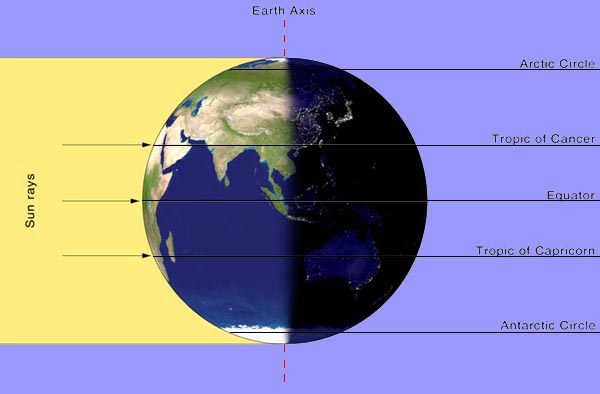 |
| Earth at the equinoxes (Wikipedia) |
Note: Each of the four great turning points--solstices and equinoxes--is widely celebrated across cultures. Let's look at some springtime celebrations.
Get Ready: Does your culture or region have a special celebration for Spring Equinox? If so, what do you do?
In mid-March, Akemi is chatting with her classmate Becky in the Common Room of their dorm.
Becky: Wow! I can't believe it: Easter is just around the corner.
Akemi: Yeah! Less than a month away. And Shunbun no Hi is even closer.
Becky: What's that?
Akemi: Oh, it means something like "spring equinox."
Becky: Oh, yeah. Lily said they do that in China, too. I think she said "Chunfen"?
Akemi: I think so. In China, it's one of the 24 divisions of the year, called "Solar Terms." One of them, around April 4 or 5, is a day to go visit ancestors' graves. It's called Qing Ming in Chinese, or "Clear and Bright," but some call it "Tomb Sweeping Day."
Becky: Do you sweep tombs in Japan, too?
Akemi: Yes, but we do it on the equinox itself, around March 20 or 21. It's actually a national holiday.
Becky: You get a day off for spring equinox? Cool!
Akemi: Yeah, and another one for the autumn equinox, as well.
Becky: Well, in my country, we don't get a holiday for any solstice or equinox, and since Easter is always on Sunday, there's no special time off then, either. But some schools and companies give a half-day off on the Friday before, called "Good Friday."
Akemi: I see. So, is Easter the same day every year?
Becky: No, it moves around a lot. It's usually the first Sunday after the first full moon after the spring equinox.
Akemi: Yikes! Hard to remember.
Becky: Yeah, we just use the calendar.
Akemi: Ha! Lily said the same thing about China's Spring Festival, or Chinese New Year. I think she said it was the second new moon after Winter solstice, but most people just check the calendar.
Becky: Right. So anyway, it sounds like a lot of cultures have holidays clustered around the spring equinox.
Akemi: Yeah! I heard that even April Fools' Day has something to do with the equinox.
Becky: Maybe. But certainly all of these days--your festival in Japan, Easter, even April Fools'--are related to spring.
Akemi: How do you mean?
Becky: Well, your day, Shunbun, is obvious. But look at Easter symbols: eggs, baby chicks, rabbits--these are all symbols of new life, which happens in the spring.
Akemi: And April Fools'?
Becky: Well, who doesn't get a little silly when spring arrives?
Akemi: Gotcha!
NOTES:
- Shunbun no Hi is pronounced "Shoon boon no hee"; the characters for Shunbun are 春分, the same as the Chinese Chunfen.
- China's Solar Terms are 24 more-or-less equal divisions of the year. Although the Chinese calendar is lunisolar (that is, based on the moon, but with yearly adjustments to keep it connected to the sun year), the Solar Terms are almost strictly solar. In Chinese they're called jieqi (节气).
Read more: https://en.wikipedia.org/wiki/March_equinox
Practice: Match the term to its definition below:
- ancestors
- clustered
- Easter
- full moon
- Good Friday
- gotcha
- I can't believe it
- just around the corner
- new moon
- spring equinox
- tomb
- winter solstice
- yikes
- arranged together in a group
- happening soon
- not literally, but used to mean something is remarkable or surprising
- family members who came before us
- the shortest day of the year in the northern hemisphere, around December 20 or 21
- when the moon shines the brightest
- the day Christians believe Jesus was killed
- the day Christians believe Jesus came back to life
- an expression of surprise, or maybe confusion
- when the moon is darkest
- one of the two days a year when days and nights are about equal in length; in the northern hemisphere, it's around March 20 or 21
- a place where someone is buried; also called a grave
- I understand
Answers are in the first comment below.
Submitted to the Shenzhen Daily for March 15, 2012
This lesson received 181 visits on my old site between March, 2012, and July, 2021.


Answers to the Practice: 1. d; 2. a; 3. h; 4. f; 5. g; 6. m; 7. c; 8. b; 9. j; 10. k; 11. l; 12. e; 13. i
ReplyDelete